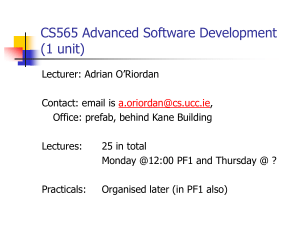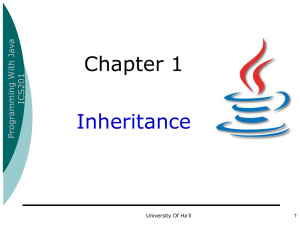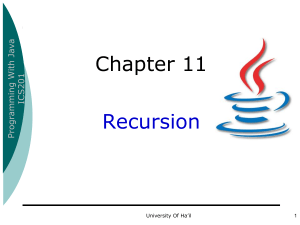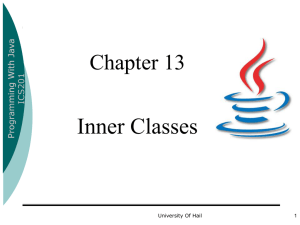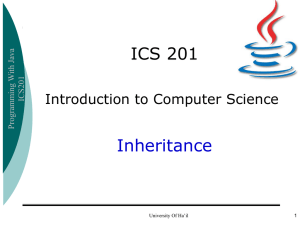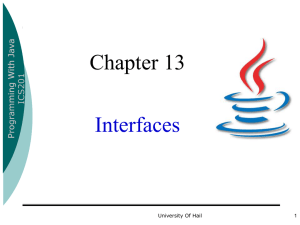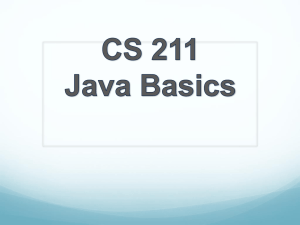UML
advertisement
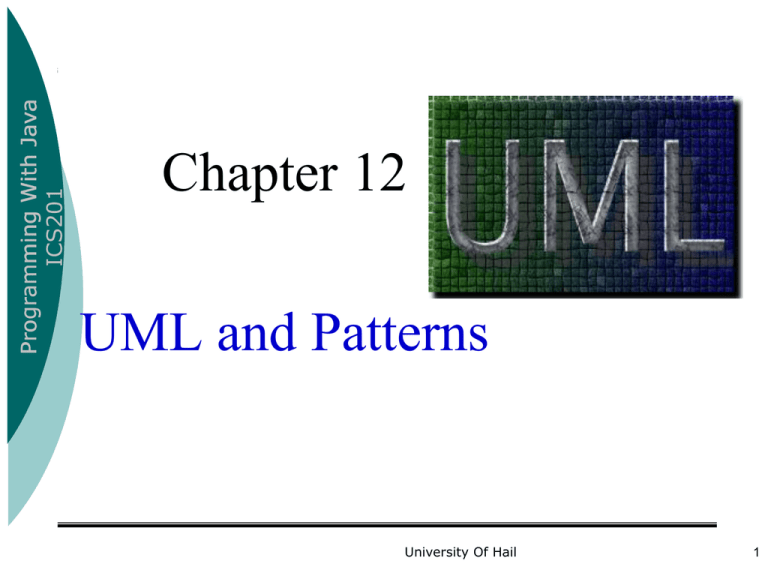
Programming With Java ICS201 Chapter 12 UML and Patterns University Of Hail 1 Programming With Java ICS201 Introduction to UML o UML (Unified Modeling Language) is a graphical language used for designing and documenting OOP software. o UML is a software design tools that can be used within the context of any OOP (Object-Oriented programming) language. University Of Hail 2 Programming With Java ICS201 UML o Pseudocode is a way of representing a program in a linear and algebraic manner. It simplifies design by eliminating the details of programming language syntax. o Graphical representation systems for program design have also been used: Flowcharts and structure diagrams for example. o Unified Modeling Language (UML) is yet another graphical representation formalism. UML is designed to reflect and be used with the OOP philosophy. University Of Hail 3 Programming With Java ICS201 Types of UML Diagrams • Use Case Diagram • Class Diagram • Sequence Diagram • Collaboration Diagram • State Diagram • …. Programming With Java ICS201 Classes •A class is simply represented as a box with the name of the class inside – The diagram may also show the attributes and operations – The complete signature of an operation is: operationName(parameterName: parameterType …): returnType Rectangle Rectangle getArea resize Rectangle height width Rectangle Rectangle height width height: int width: int getArea resize getArea(): int resize(int,int) 5 Programming With Java ICS201 UML Class Diagram o A class diagram is divided up into three sections: 1.The top section contains the class name. 2.The middle section contains the data specification for the class (attributes). 3.The bottom section contains the actions or methods of the class (operations). ClassName attributes operations University Of Hail 6 Programming With Java ICS201 Class Names ClassName attributes operations The name of the class is the only required tag in the graphical representation of a class. It always appears in the top-most compartment. Programming With Java ICS201 Class Attributes (Cont’d) Attributes are usually listed in the form: attributeName : Type Person + name # address # birthdate / age - ssn : String : Address : Date : Date : Id Attributes can be: + public # protected - private / derived A derived attribute is one that can be computed from other attributes. For example, a Person’s age can be computed from his birth date. / age : Date Software Design (UML) Programming With Java ICS201 Class Operations Operations describe the class behavior Person name address birthdate ssn : String : Address : Date : Id eat sleep work play and appear in the third compartment. o Each method in a UML diagram is indicated by the name of the method, followed by its parameter list, a colon (:), and its returned type. Software Design (UML) Programming With Java ICS201 UML Class Diagram o A class diagram need not give a complete description of the class. o If a given analysis does not require that all the class members be represented, then those members are not listed in the class diagram. o Missing members are indicated with an ellipsis (three dots). University Of Hail 10 Programming With Java ICS201 Example (UML Class Diagram) Square attributes - Side : double - xCoordinate : double - yCoordinate : double Class name + resize (double newSide) : void + move (double newx , double newy ) : void # erase ( ) : void … University Of Hail Class methods 11 Programming With Java ICS201 Inheritance Diagrams (Generalization) o An inheritance diagram shows the relationship between a base class and its derived class(es). Normally, only as much of the class diagram is shown as is needed. Note that each derived class may serve as the base class of its derived class(es). o Each base class is drawn above its derived class(es) An upward pointing arrow is drawn between them to indicate the inheritance relationship. University Of Hail 12 Programming With Java ICS201 Inheritance Diagrams o The arrows also help in locating method definitions. o To look for a method definition for a class: Examine the class definition first. If the method is not found, the path of connecting arrows will show the order and direction in which to search. Examine the parent connecting arrow. class indicated by the If the method is still not found, then examine this parent's parent class indicated by the connecting arrow. Continue until the method is found, or until the top base class is reached. University Of Hail 13 Programming With Java ICS201 A Class Hierarchy in UML Notation Person Arrows go from a derived class to its base class. Student Undergraduate Employee Graduate Faculty University Of Hail Staff 14 Programming With Java ICS201 Some Details of a Class Hierarchy Person - name: String + setName(String newName): void + getName( ): String + toString( ): String + sameName(Person otherPerson): boolean Student - studentNumber: int + set(String newName , int newStudentNumber): void + getStudentNumber( ): int + setStudentNumber(int newStudentNumber ): void + toString( ): String + equals(Object otherObject): boolean University Of Hail 15 Programming With Java ICS201 Example • Consider the class named Book that contains: – – – – – A private String variable called title; A private integer variable called nbpages; A public double variable called price ; Two public methods SetTitle() and SetNbpages(); Two public methods getTitle() and getNbpages(); • Class TextBook is a derived class from the class Book. It contains: – A protected integer variable called gradeLevel; – A public method toString() that returns a description of a textBook; – A public method PriceAfterDiscount() that returns the price of a book after applying a discount of 10%. • Question: Establish the UML diagram for this problem. Programming With Java ICS201 + + + + + Book title : String nbpages : int price : double SetTitle (String t) : void SetNbpages (int nb) : void getTitle ( ) : String getNbpages ( ) : int TextBook # gradeLevel : int + toString ( ) : String + PriceAfterDiscount() : double
